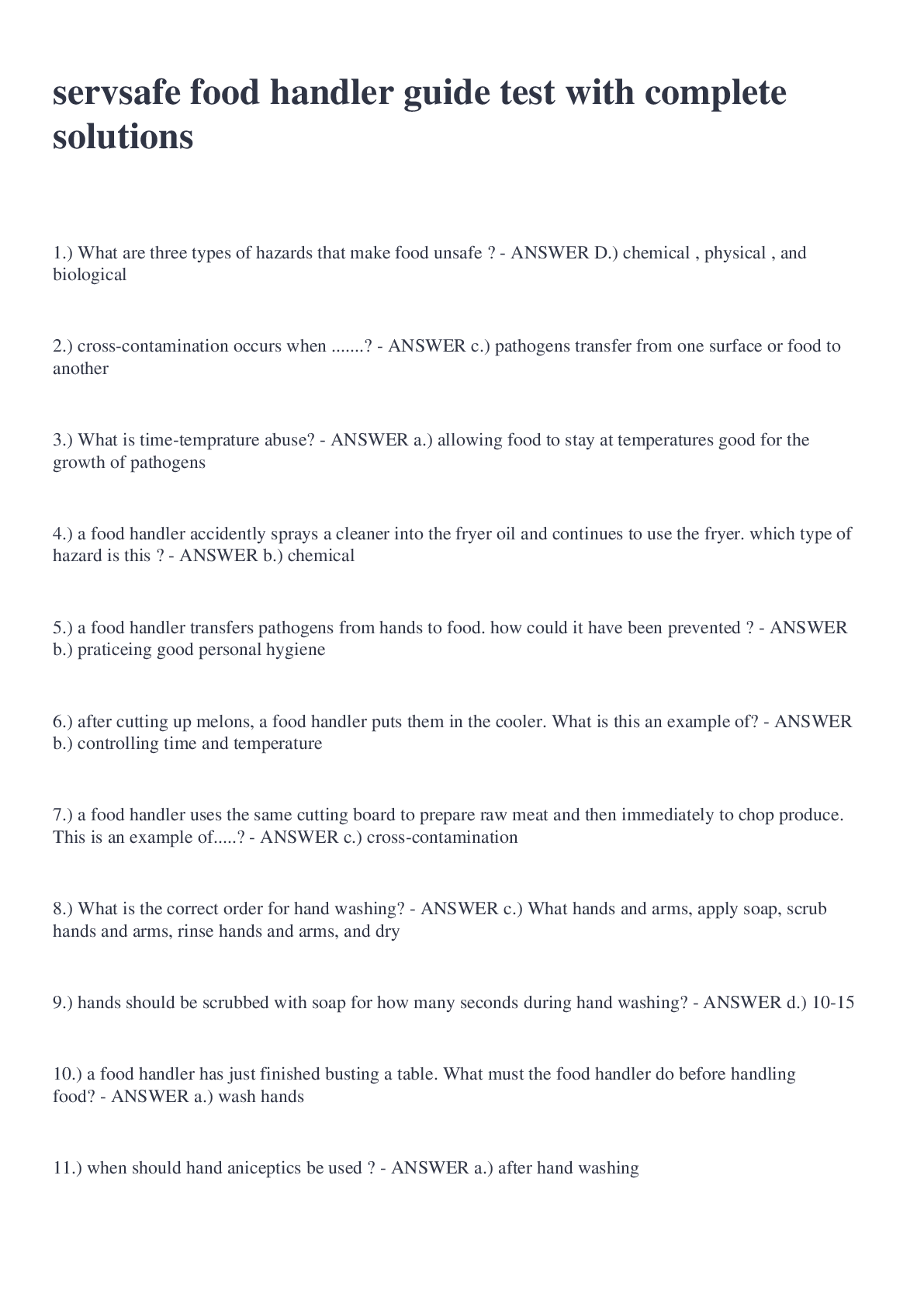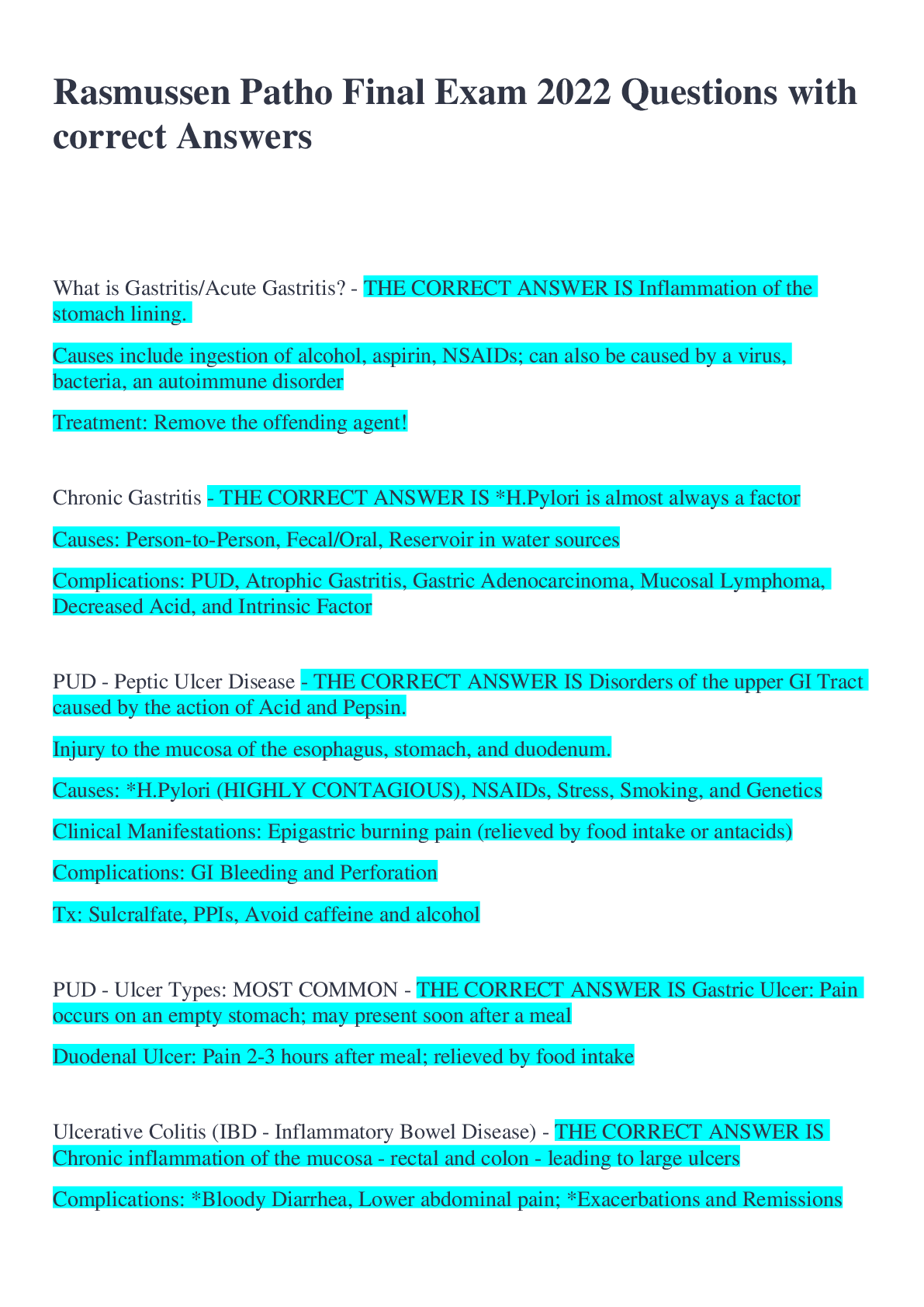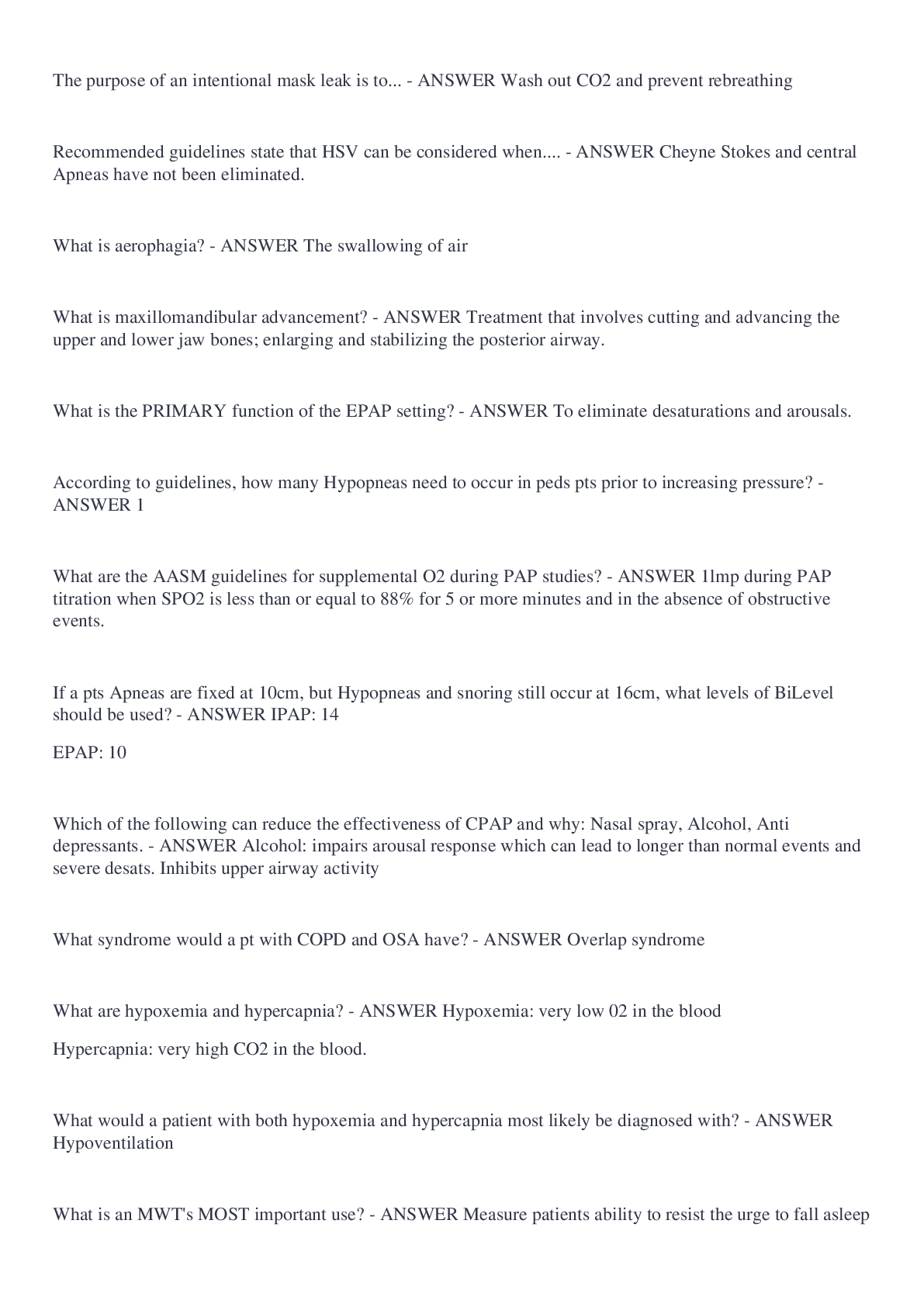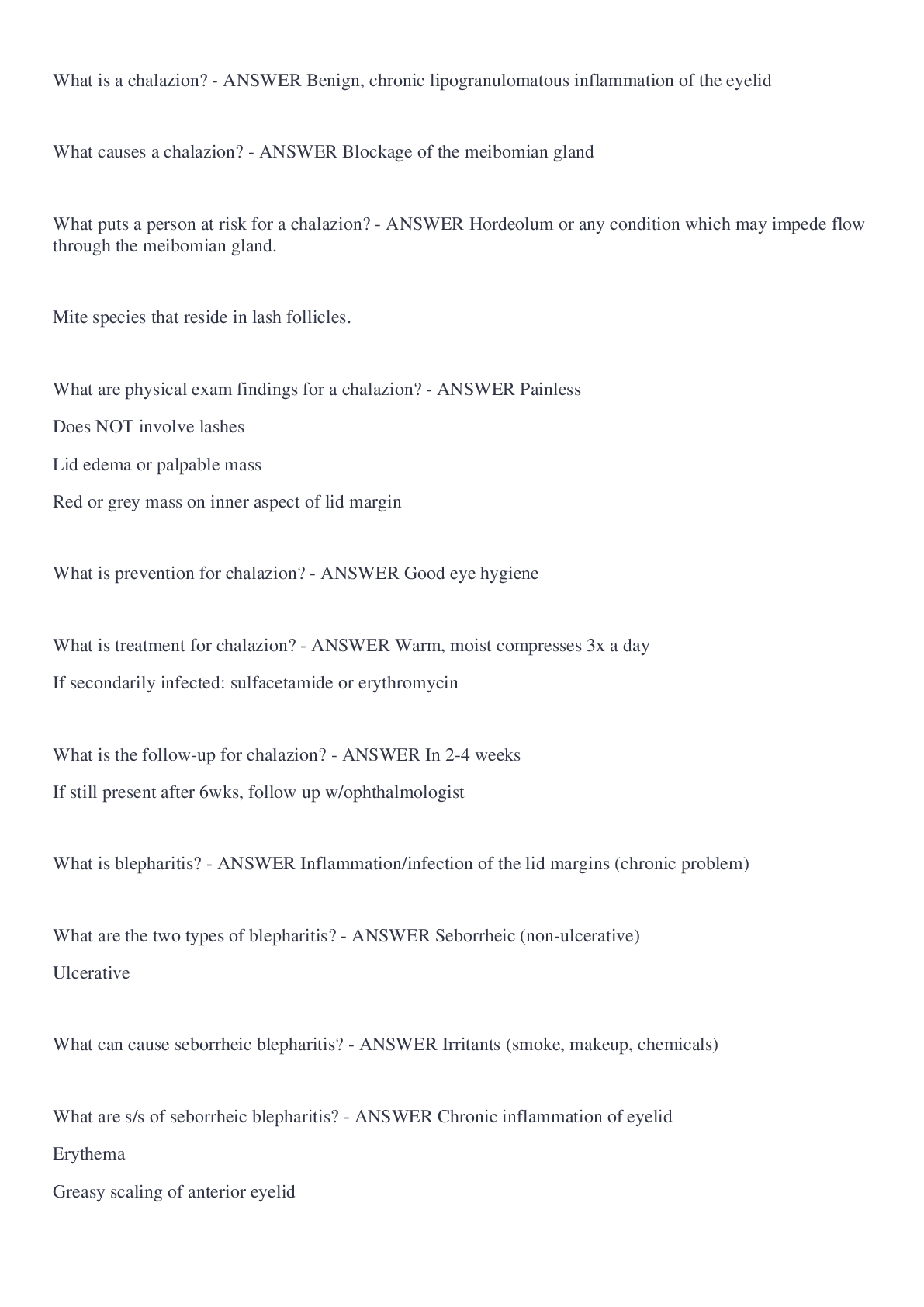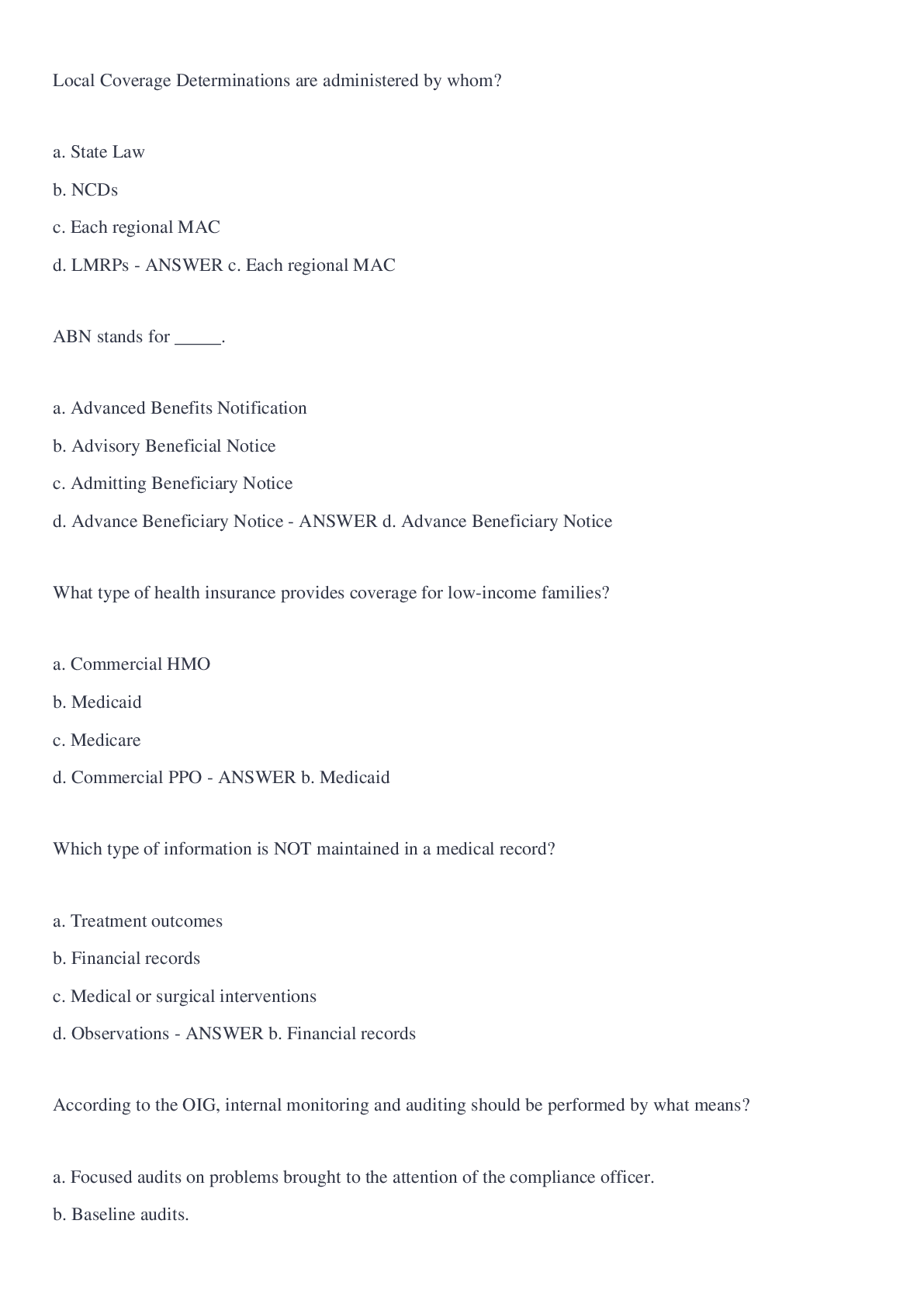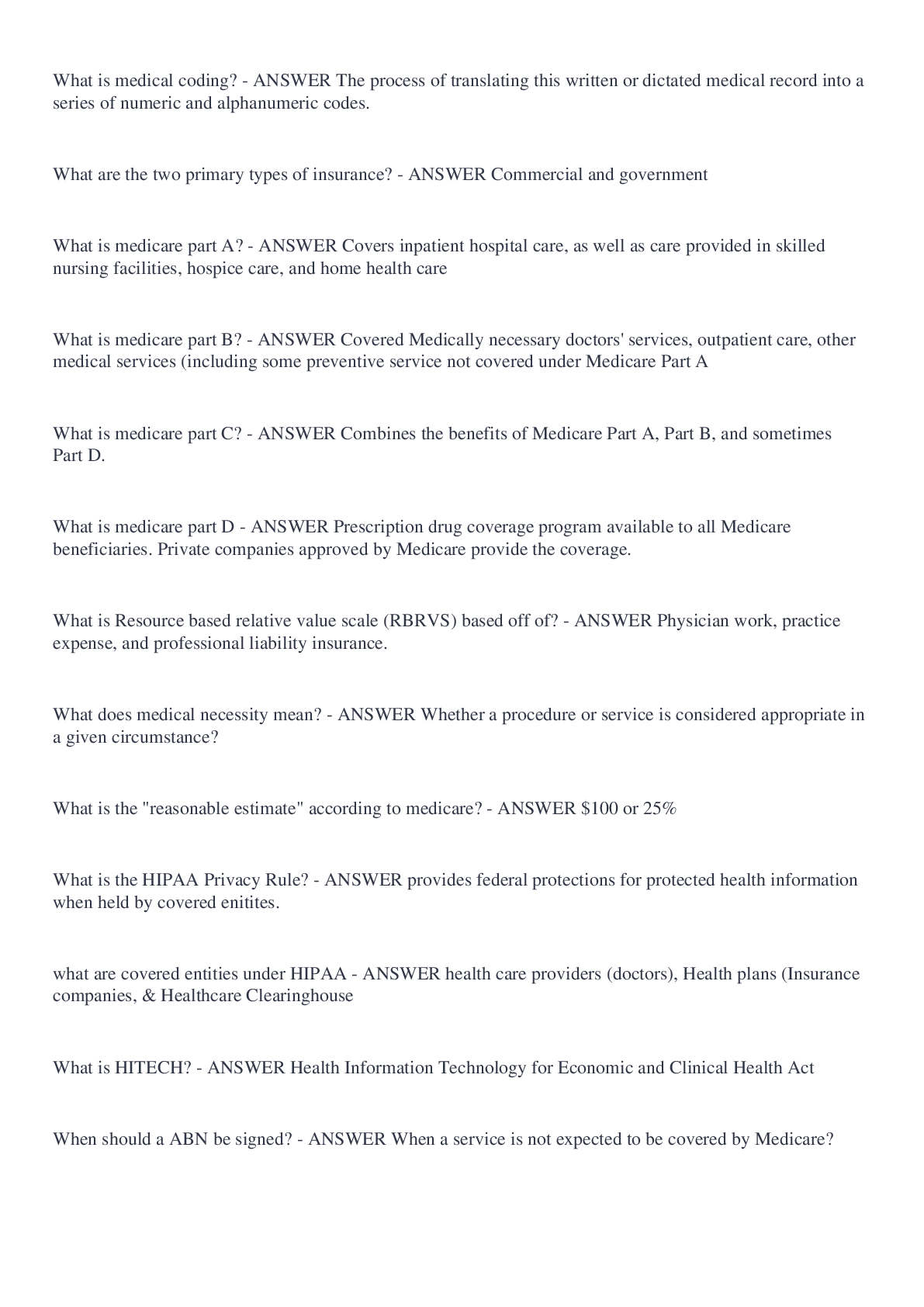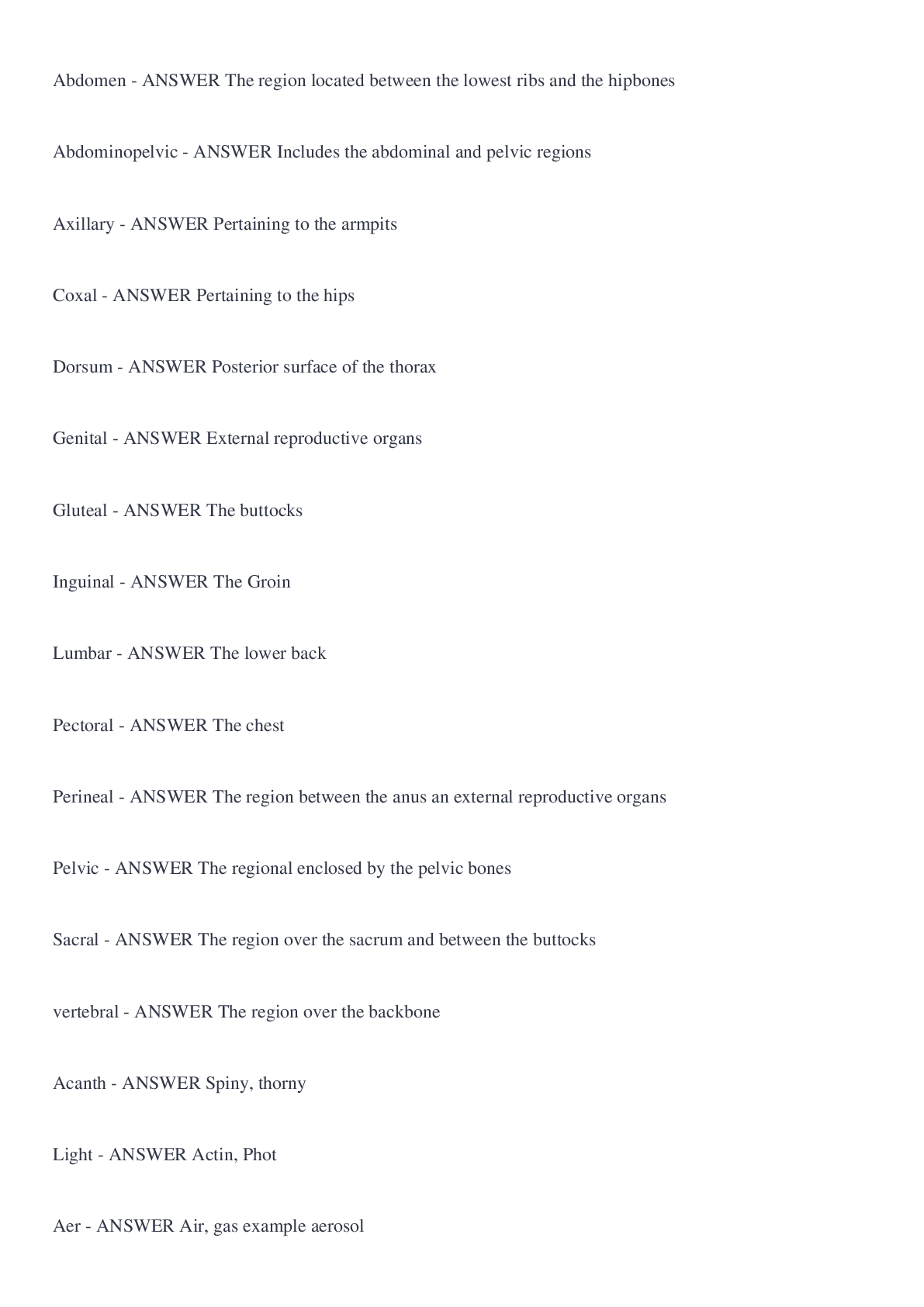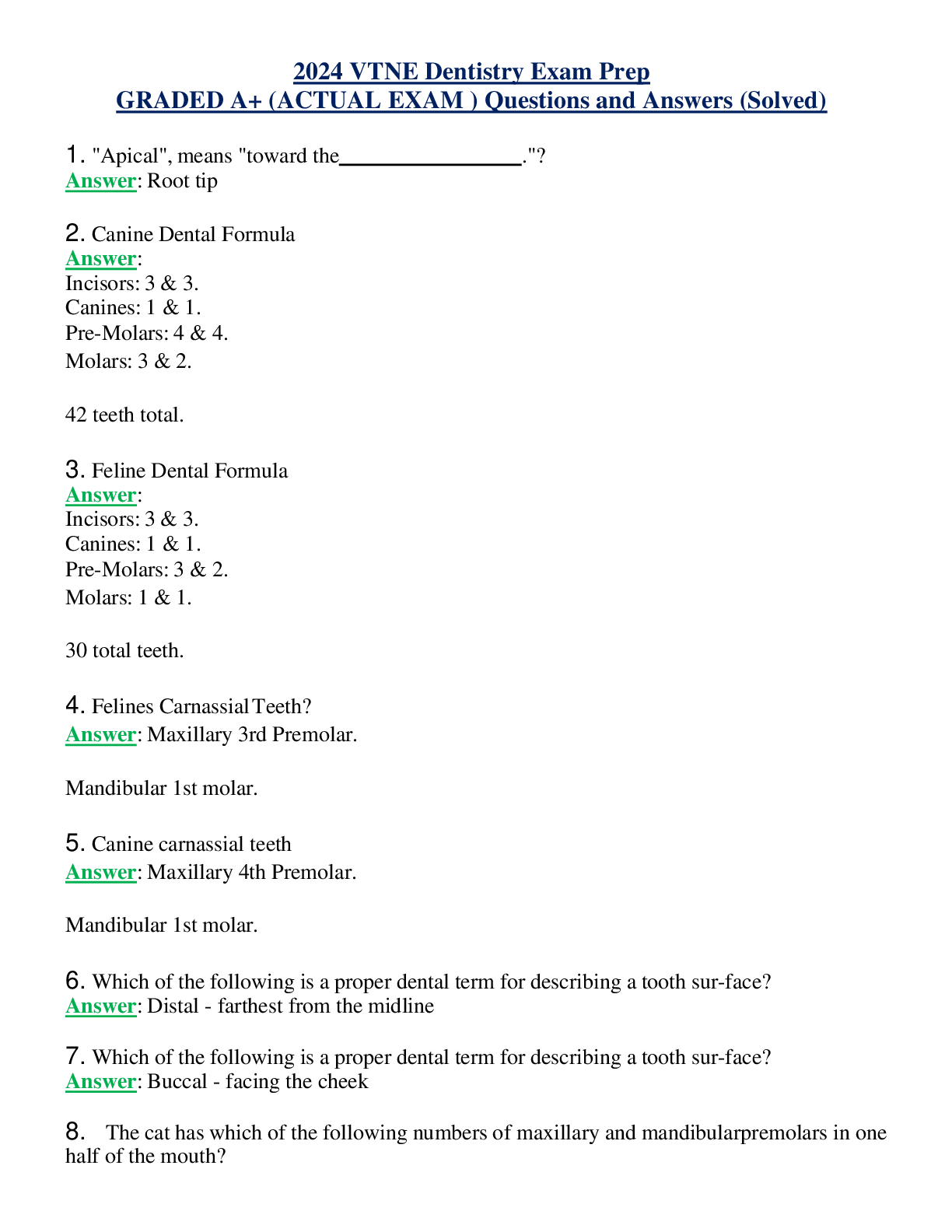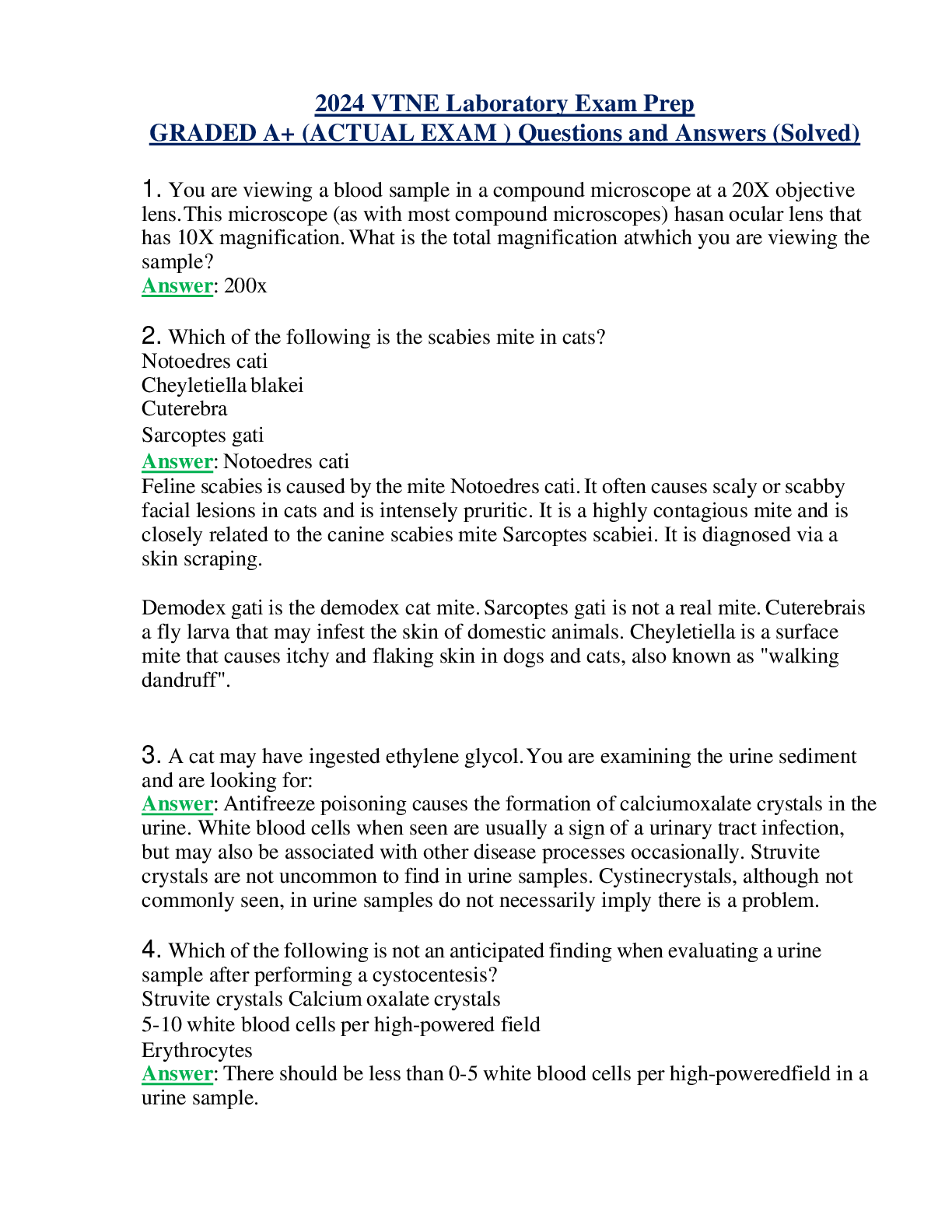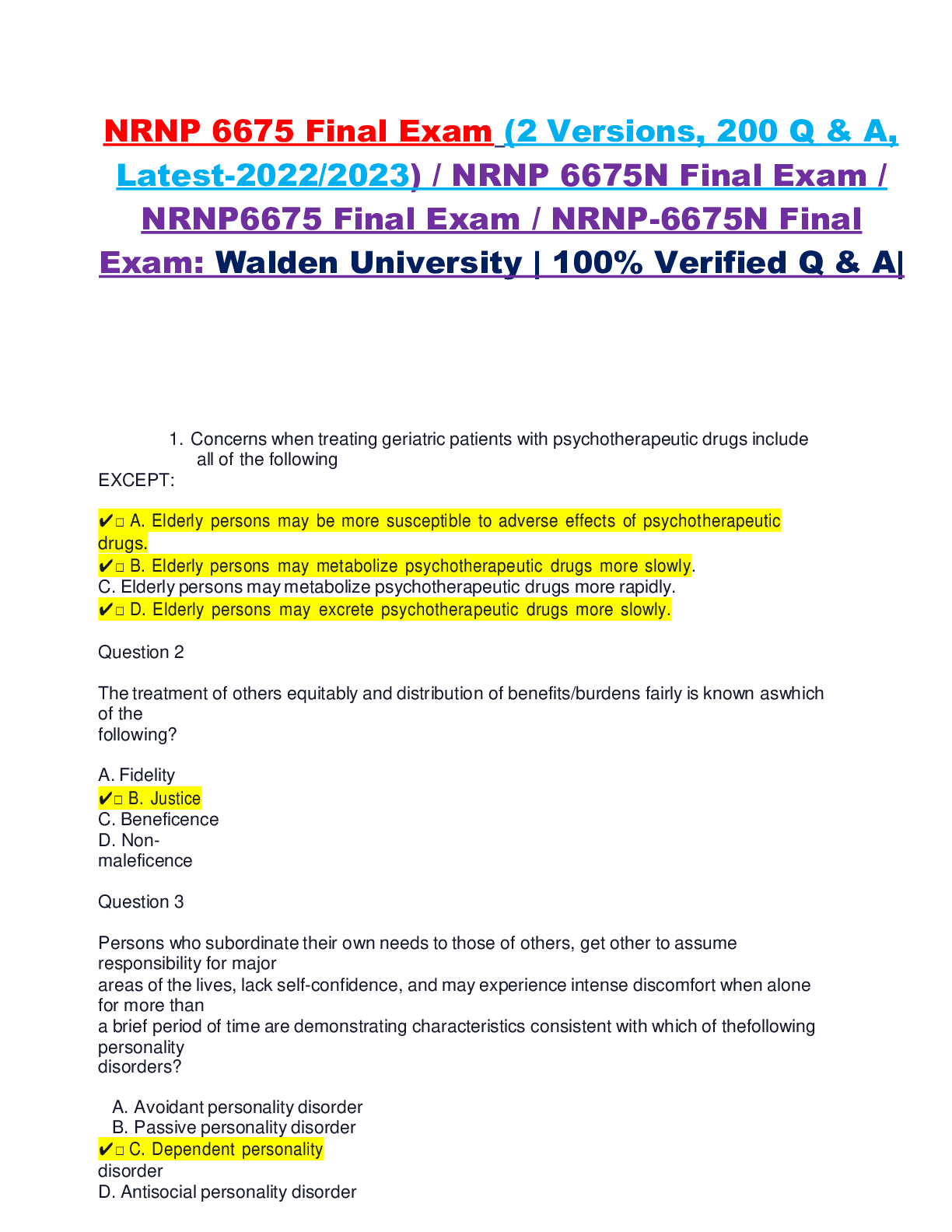FISDAP READINESS Exam Prep Graded A+ (Q BANK)
Document Content and Description Below
Where are Beta 1 receptors found? - ANSWER Heart and Kidneys Stimulation of Beta 1 receptors result in an increase of what? - ANSWER Heart: Inotropy, Chronotropy, Dromotropy Kidneys: Renin-Angio... tensin-Aldosterone System = Vasoconstriction = Increase blood pressure Which node is located at the junction of the superior vena cava and the right atrium, is typically supplied by the Right Coronary artery, and fires at a rate of 60-100 bpm. - ANSWER SA Node Atrial depolarization characterized by smooth, round, upright deflection less than 0.11 secs long and less than 2.5mm tall is referred to as what on the ECG? - ANSWER P wave Carvedilol (Coreg) Metropolol (Lopressor) Atenolol (Tenormin) Propranolol (Inderal) Bisoprolol (Zebeta) Acebutolol (Sectral) Comolol (Brevibloc) - ANSWER Beta Blockers - used for blood pressure and cardiac problems Epinephrine Norepinephrine Vasopressin Dopamine Phenylephrine Dobutamine - ANSWER Vasopressors The middle of phase 3 to beginning of phase 4 in the cardiac cycle where cardiac cells are partially refractory and partially repolarized and certain cells can be depolarized in response to electrical stimulus. - ANSWER Relative Refractory Period (Partial flush of the toilet) Treatment for Beta Blocker Overdose - ANSWER Glucagon: 1-5mg IV/IO (1st Line Drug) Calcium Chloride: 500mg - 1g IV/IO Swelling of affected limb, pain and tenderness, inflammation/redness, warm to touch on affected limb, pain on dorsiflexion (Homan Sign) are all signs of? - ANSWER DVT Treatment of DVT - ANSWER Supportive Care, Position of Comfort, Establish IV, Cardiac Monitor, Pulse Ox, O2, Monitor vitals for embolism. Do not massage affected limb. The pressure gradient that drives coronary blood pressure. The difference between aortic diastolic pressure and left ventricular end diastolic pressure that perfuses the coronary arteries. - ANSWER Coronary Perfusion Tachycardia, Difficulty Breathing, Diminished Lung Sound, Pulse Quality Changes, and unequal chest rise are early signs and symptoms of? - ANSWER Tension Pneumothorax Air is entering the pleural space but cannot escape. Positive pressure ventilation can make it worse. Criteria for Unstable Dysrhythmia - ANSWER Ischemic Chest Pain ALOC Hypotension/Hypovolemia Signs of Shock Acute Heart Failure Restriction of of cardiac contraction, falling cardiac output, and shock as a result of pericardial fluid accumulation are characteristics of? - ANSWER Cardiac Tamponade Hypotension, SOB, Lightheadedness, Chest Pain, Syncope, Palpitations, Extremity Swelling, and Muffled heart sounds are signs and symptoms of? - ANSWER Cardiac Tamponade Indications for Dopamine - ANSWER Cardiogenic Shock Distributive Shock after fluids Hemodynamically significant Hypotension Symptomatic Brady (2nd Line drug) AHA Guidlines for Terminating CPR efforts in field(4) - ANSWER Arrest was not witnessed No bystander CPR was administered ROSC was not achieved after complete ALS care in the field No shocks were administered Time frame that starts at the patient contact by EMS and ends with definitive therapy of catheter passing through lesion of coronary vessel. - ANSWER EMS-to-Balloon-Time Time from patient entering ED to catheter passing through lesion of coronary vessel. - ANSWER Door-to-balloon-time Time from patient entering ED to fibrinolytic therapy administration. - ANSWER Door-to-needle-time Time frame for door-to-balloon - ANSWER <90mins Time frame for door-to-needle - ANSWER <30mins Principle symptom of Coronary Artery Disease or Acute Coronary Syndrome that occurs when supply of O2 is to the myocardium is insufficient to meet demand and cells become ischemic? - ANSWER Angina Pectoris Chest pain that occurs at rest and is caused by coronary artery vasospasm? Risk for Dysrhythmia, MI, Heart Block and Death - ANSWER Prinzmetal Angina (PA) Which electrolyte flows into cardiac cells to initiate depolarization? - ANSWER Sodium (Na+) Which electrolyte flows out of cardiac cells to to initiate repolarization? - ANSWER Potassium (K+) Which electrolyte plays a major role in depolarization of pacemaker cells to maintain depolarization and myocardial contractility? - ANSWER Calcium (Ca++) Which electrolyte stabilizes cell membrane and acts in concert with K+ and opposes actions of Ca++? - ANSWER Magnesium (Mg++) Hypokalemia results in? - ANSWER increased myocardial irritability Hyperkalemia results in? - ANSWER decreased automaticity/conduction Hypocalcemia results in? - ANSWER decreased contractility and increased irritability Hypercalcemia results in? - ANSWER Increased contractility Hypomagnesemia results in? - ANSWER decreased conduction Hypermagnesemia results in? - ANSWER increased myocardial irritability Four properties of the Cardiac Conduction System - ANSWER Excitability - cells respond to electrical impulse Conductivity - cells pass impulse to one another Automaticity - hearts ability to generate its own electrical impulse Contractility - hearts ability to contract when stimulated Affects of RCA occlusion in terms of the SA node ischemia? - ANSWER SA node becomes ischemic = slower firing rate (<60-100) or cease fire completely causing another automaticity foci to take over such as AV (40-60) or Purkinje (20-40). Which electrolytes are responsible for depolarization? - ANSWER Sodium and Calcium influx Which electrolyte is responsible for repolarization? - ANSWER Potassium outflow Indications for CPAP (5) - ANSWER Alert and able to follow commands Moderate to Severe Respiratory Distress Hyperventilation SpO2 <90% Systolic >90mmHg Contraindications for CPAP (8) - ANSWER Respiratory Arrest Hypoventilation ALOC Chest Trauma/Pneumo Tracheostomy GI bleed or Vomiting Inability to fit CPAP Excessive Facial Hair/Dysmorphic features During what phase of circulation do coronary arteries receive blood? - ANSWER Diastolic Coronary circulation begins from aorta at the? - ANSWER Right and Left Coronary Arteries The right coronary artery has how many branches and supplies blood to where? - ANSWER 9 Right Atrium, SA/AV node, and Right Ventricle Inferior Left Ventricle Left Coronary Artery is the largest and shortest coronary vessel. It divides into what and supplies blood to where? - ANSWER Left Anterior Descending and Circumflex Coronary arteries. Left Ventricle, Septum, and at times the AV node and atria. Epinephrine MOA (4) and Dose - ANSWER Beta 1 = Inotropy, Chronotropy, Dromotropy Alpha 1 = Vasoconstriction = Increased aortic diastolic pressure Beta 2 = Bronchial smooth muscle relaxation = Bronchodilation Adequately perfused kidneys produce how many mLs of urine per hour? - ANSWER 30-50mL Tachycardia with irregular pulse, labored breathing with diffuse crackles/rales in all lung fields, pale/cool/diaphoretic skins, and low blood pressure are signs of what type of shock? - ANSWER Cardiogenic What is one of the most helpful steps to formulating a field diagnosis? - ANSWER Considering and ruling out various conditions A sudden nervous system reaction that causes temporary generalized vasodilation leading to syncope describes what type of shock? - ANSWER Psychogenic Allowing full recoil of the chest in CPR enhances blood return to the heart by what mechanism? - ANSWER Negative intrathoracic pressure If someone has a syncopal episode and then complains of headache and inability to walk without feeling dizzy, you should suspect? - ANSWER Head Injury Treatment for neurogenic shock includes IV fluids, temperature management, and possibly? - ANSWER Atropine 0.5mg up to 3mg Suppress vagus nerve to increase cardiac output. What is the most important criteria for bystander CPR to meet prior to EMS arrival? - ANSWER Compressions Which system is primarily responsible for tissue perfusion? - ANSWER Cardiovascular The recommended fluid resuscitation for a patient in shock with no suspected TBI is? - ANSWER 250mL up to 4x, maintain systolic of 80-90mmHg What type of metabolism takes over when inefficient cellular metabolism produces lactic acid? - ANSWER Anaerobic Accumulation of lactic acid and other waste products in the blood inhibits what interaction? - ANSWER hemoglobin from binding with and carrying oxygen What should you do if you are working a cardiac arrest patient and the capnography spikes from <20mmHg to >40mmHg? - ANSWER Assess pulse for up to 10 seconds Tendency to gather or rely on information that confirms your existing views and downplays/avoids info that does not confirm your hypothesis or field differential is what kind of bias? - ANSWER Confirmation Bias The primary focus of running a megacode should be on? - ANSWER teamwork and minimal interruptions of CPR What causes increased afterload following Alpha-1 stimulation? - ANSWER Arteriolar constriction What senses decrease in blood flow and activates the vasomotor center in response? - ANSWER Baroreceptors Increased rate of breathing that leads to respiratory alkalosis occurs during which stage of shock? - ANSWER Compensated Hyperventilating a cardiac arrest patient reduces what? - ANSWER coronary perfusion What is a procedure that would require a sterile cockpit approach? - ANSWER RSI What causes hypovolemia in septic shock patients? - ANSWER Fluid leaks out of vascular space What intervention is indicated for a ROSC patient who remains comatose besides vitals, 12-lead, and temperature regulation? - ANSWER ET Intubation No pulse with CPR and JVD is indicative of? - ANSWER Cardiac Tamponade Crushing chest pain with ST-Elevation in V1-V4 would indicate an infarct in which artery? - ANSWER Left Anterior Descending Pedal edema, enlarged abdomen, and JVD are associated with failure of which ventricle? - ANSWER Right An S3 heart sound in older adults signifies? - ANSWER Heart Failure A run of VTach is classified by how many sequential PVCs? - ANSWER 3+ Point of maximal impulse is anatomically located where? - ANSWER Left anterior chest Midclavicular 5th ICS When cardiac cell wall permeability changes and sodium rushes into the cell, it initiates? - ANSWER Depolarization The right atrium, right ventricle and part of the left ventricle are supplied by that artery? - ANSWER Right Coronary Artery Decreased cardiac output with a HR >150 is caused by decreases in? - ANSWER Stroke volume and ventricular filling What type of angina is characterized by awaking a person at rest/sleep? - ANSWER Unstable (Prinzmetal) Slurring in the upstroke of the first part of QRS complex is called a? - ANSWER Delta wave Pain in legs while walking that is relieved after sitting down for a little while is indicative of? - ANSWER Peripheral arterial disease Fever, chills, SOB, hx of mitral valve prolapse, and flat painless red lesions on palms of hands is indicative of? - ANSWER Endocarditis (Janeway lesions) A heart experiencing an extended refractory period would reflect what on an ECG? - ANSWER Prolonged QT A tachycardic pacemaker rhythm is called? - ANSWER runaway pacemaker The volume of the blood that enters the ventricles by atrial contraction is called? - ANSWER Atrial Kick A 60-year-old male complains of a tearing sensation in his abdomen. He tells you the pain began suddenly and feels like someone is sticking a knife into his abdomen. He is conscious and alert with a blood pressure of 148/88 mm Hg, a pulse of 120 beats/min, and respirations of 22 breaths/min. In addition to administering high-flow oxygen, you should: - ANSWER Transport at once and be prepared to treat him for shock. -Given the onset and nature of the patient's pain (eg, sudden onset, tearing sensation), you should suspect that he has an acute dissection of the abdominal aorta. Administer high-flow oxygen and transport him at once. What can an acute aortic dissection cause? - ANSWER Acute aortic dissection can quickly cause an aneurysm, which could rupture and cause profound shock. A 72-year-old woman is found unresponsive in her poorly ventilated home. Her skin is flushed, hot, and dry, and her respirations are rapid and shallow. She is wearing a medical alert bracelet that states she is a diabetic and is allergic to sulfa drugs. You should be MOST suspicious for: - ANSWER Heat stroke. -classic heat stroke commonly affects children and older adults, and typically occurs when the patient is in a hot, poorly ventilated space for a prolonged period of time. Signs of narcotic (opiate) overdose - ANSWER altered mental status; slow, shallow breathing; pupillary constriction (miosis), hypotension; and bradycardia. -Narcotics are central nervous system depressants that, when taken in excess, suppress the vital functions necessary for life, such as breathing, heart rate, and blood pressure. S/S of methamphetamine overdose - ANSWER Increased heart rate and blood pressure, pupillary dilation, agitation and hyperthermia. Your FIRST action in managing a patient with an altered mental status should be to: - ANSWER Determine if the patient is breathing adequately. -When treating a patient with an altered mental status, you must first ensure a patent airway and determine if the patient is breathing adequately. If the patient is breathing adequately, administer supplemental oxygen and continue your assessment. If the patient is not breathing adequately (ie, fast or slow rate, shallow breathing [reduced tidal volume]), assist his or her ventilations. Propoxyphene (Darvon) is categorized as which type of drug? - ANSWER Propoxyphene (Darvon) is in the narcotic (opiate) class of drugs. Other narcotics include heroin, morphine, codeine, and meperidine (Demerol). Which of the following structures is responsible for regulating body temperature? - ANSWER Hypothalamus. -The hypothalamus, which is located within the brain stem, regulates body temperature by acting as the body's thermostat. During a heat-related emergency, the hypothalamus can "reset" the body's normal temperature to a much higher temperature in response to the environment and the body's inability to eliminate heat. When insulin levels in the blood remain high: - ANSWER Glucose is rapidly taken out of the blood to fuel the cells -Insulin is a hormone that promotes the cellular uptake of glucose from the bloodstream. If insulin levels remain high, such as when a diabetic inadvertently takes too much insulin, glucose is rapidly taken out of the blood to fuel the cells. This leads to low circulating blood glucose levels (hypoglycemia) and a condition called insulin shock What is insulin shock? - ANSWER If insulin levels remain high, such as when a diabetic inadvertently takes too much insulin, glucose is rapidly taken out of the blood to fuel the cells. This leads to low circulating blood glucose levels (hypoglycemia) and a condition called insulin shock What happens when insulin levels are too low? - ANSWER if insulin levels are too low, such as when a diabetic forgets to take his or her insulin, glucose cannot enter the cells and pools in the bloodstream (hyperglycemia) What happens in the absence of glucose? - ANSWER the cells begin to metabolize fat, which produces ketoacids (diabetic ketoacidosis [DKA]). The respiratory system attempts to eliminate ketoacids from the blood with an increased rate and depth of breathing (Kussmaul respirations) that is accompanied by a fruity or acetone breath odor. What does hyperglycemia cause? - ANSWER It causes the patient to eliminate excess water from the body through urination *(diuresis)*, resulting in dehydration What accompanies insulin shock (hypoglycemic crisis) - ANSWER Presents with cool, clammy skin and a rapid onset. What is a diabetic coma? - ANSWER Hyperglycemic crisis, typically presents with warm, dry skin and a slow onset, sometimes over a period of days What are the signs of CNS depressants? - ANSWER Like benzos (sedative-hypnotic) they include a decreased level of consciousness, hypoventilation, bradycardia, and hypotension. What are sympathomimetic drugs? - ANSWER They mimic the effects of the sympathetic (fight or flight) nervous system; therefore, restlessness or hyperactivity, hypertension, tachycardia, and pupillary dilation. What formula is used to calculate a patient's weight into kilograms? - ANSWER -Weight (in pounds)/2.2= weight in kg -(weight in pounds)/2 then minus 10% of the kg and round to the nearest tenth. Which of the following signs or symptoms is MOST suggestive of a systemic reaction following ingestion of a poison? - ANSWER Tachycardia and hypotension. -Once an ingested poison gets into the body, it can affect multiple organ systems. Signs that this is occurring include tachycardia or bradycardia, hypotension or hypertension, weakness, restlessness, and an altered level of consciousness, among others. What are local effects of ingested poison? - ANSWER nausea and vomiting as the poison irritates the gastric lining, burns in and around the mouth, and painful or difficult swallowing (dysphagia). A 73-year-old male presents with confusion; cool, pale, clammy skin; absent radial pulses; and a blood pressure of 70/40 mm Hg. The patient's wife tells you that he has had abdominal pain for a week and began vomiting a coffee-ground substance yesterday. His past medical history includes hypertension and gastric ulcer disease. Your MOST immediate concern should be that: - ANSWER The patient is likely bleeding from his gastrointestinal (GI) tract. Although this is a serious condition, it is not a condition you can treat; internal bleeding cannot be controlled in the field. You can, however, treat his signs and symptoms of shock by administering high-flow oxygen and keeping him warm by covering him with a blanket. Therefore, this should be your most immediate concern. Furthermore, the patient requires prompt transport What are the S/S of a gastrointestinal (GI) bleed including abdominal pain? - ANSWER vomiting blood (hematemesis); the passage of dark, tarry stools (melena); and bright red rectal bleeding (hematochezia) -If blood loss is significant, the patient may have signs of shock (eg, tachycardia, diaphoresis, tachypnea, hypotension). Why isn't hemoptysis a sign of a GI bleed? - ANSWER coughing up blood is a sign of a pulmonary injury You should not attempt to actively rewarm a patient with moderate or severe hypothermia in the field because: - ANSWER Rewarming too quickly can cause a fatal cardiac dysrhythmia What should you do when caring for a patient with hypothermia? - ANSWER When caring for a patient with hypothermia, your goal is to prevent further heat loss; this involves removing wet clothing, applying warm blankets, and allowing the patient's body temperature to rise gradually and naturally (passive rewarming). What is rewarming shock? - ANSWER a condition in which the blood vessels dilate when heat is applied to the body, resulting in significant hypotension. You receive a call to a restaurant where a 34-year-old man is experiencing shortness of breath. When you arrive, you immediately note that the man has urticaria on his face and arms. He is conscious, but restless, and is in obvious respiratory distress. You should: - ANSWER place a nonrebreathing mask set at 15 L/min on the patient. -Initial management of a patient with a suspected allergic reaction is to ensure a patent airway and provide high-flow oxygen. Positive-pressure ventilation may be required if the patient is breathing inadequately. After ensuring a patent airway and adequate ventilation and oxygenation, you should inquire whether the patient has a prescribed epinephrine auto-injector. If so, you should contact medical control and obtain permission (if required by local protocol) to assist the patient with the auto-injector. What are the early S/S of viral hepatitis? - ANSWER Loss of appetite (anorexia), vomiting, fever, fatigue, and muscle/joint pain. What is the function of insulin? - ANSWER facilitates the entrance of glucose into the cells. What is insulin? - ANSWER Insulin is a hormone produced by the beta cells in the islets of Langerhans of the pancreas. It promotes the uptake of glucose from the bloodstream into the cells, where it is used in the production of energy. What is glucagon? - ANSWER Glucagon, a hormone produced by the alpha cells in the pancreas, facilitates the conversion of glycogen to glucose (glycogenolysis) in the liver. The two MOST important steps in treating a patient with a contact poisoning are: - ANSWER avoiding self-contamination and removing the irritating or corrosive substance from the patient as rapidly as possible. A 24-year-old female presents with a rash to her left leg and swollen, painful knee joints. She tells you that she and her friends returned from a hiking trip in the mountains a week ago. She is conscious and alert with a blood pressure of 112/62 mm Hg, a pulse of 84 beats/min, and respirations of 14 breaths/min. Her symptoms are MOST likely the result of: - ANSWER Lyme disease What are the S/S of Lyme disease? - ANSWER The first symptom of Lyme disease, a rash that may spread to several parts of the body, begins about 3 days after the bite of an infected tick. The rash may eventually resemble a target bull's-eye pattern in one third of patients. After a few more days or weeks, painful swelling of the joints, particularly the knees, occurs. What is Rocky Mountain spotted ever? - ANSWER occurs within 7 to 10 days after being bitten by an infected tick. Its symptoms include nausea, vomiting, headache, weakness, paralysis, and possibly cardiopulmonary failure. What are other common causes of hypoglycemia? - ANSWER Taking a regular dose of insulin but not eating or taking insulin and exercising heavily. A middle-aged man was found floating face down in a small pond. When you arrive at the scene, bystanders are present, but no one has removed the patient from the water because they thought he was dead. After reaching the patient, you should: - ANSWER move him to a supine position by rotating the entire upper half of his body as a single unit. -After safely reaching a drowning victim, you should first turn him to a supine position by rotating the entire upper half of the body as a single unit; protect the cervical spine as you do this because a spinal injury cannot be ruled out. Open the patient's airway, without manipulating the neck, and begin rescue breathing while still in the water. What are the key findings to an altered mental status? - ANSWER An abnormal speech pattern, such as slurring or incoherent words An elderly man is found unresponsive in his kitchen. The patient's wife tells you that her husband has diabetes and that he took his insulin, but did not eat anything. You should suspect: - ANSWER Hypoglycemia. -Because insulin promotes the uptake of glucose into the cells, if the patient does not replace this glucose by eating, the glucose level in the blood will fall to dangerously low levels. What happens to a patient in hyperglycemia? - ANSWER Hyperglycemia occurs when a patient does not take his or her insulin. In such cases, glucose accumulates in the bloodstream and is not able to enter the cells. In the absence of glucose, the cells begin to metabolize fat, which results in the production of ketoacids and leads to hyperglycemic ketoacidosis (diabetic coma, hyperglycemic crisis). Which of the following actions should be carried out during the primary assessment of an unresponsive patient? - ANSWER Components of the primary assessment for both responsive and unresponsive patients include assessing and managing the airway and assessing and managing circulation, which includes controlling any major bleeding; assessing the rate, regularity, and quality of the pulse; and assessing the color, condition, and temperature of the skin Which of the following mechanisms cause respiratory and circulatory collapse during anaphylactic shock? - ANSWER Bronchoconstriction and vasodilation -During anaphylaxis, histamines released from the immune system cause two negative effects that result in shock (hypoperfusion): vasodilation, which causes the blood pressure to fall, and bronchoconstriction, which impairs breathing Which of the following is a physiologic effect of epinephrine when used to treat anaphylactic shock? - ANSWER as a bronchodilator and vasoconstrictor, it improves the patient's breathing and constricts the blood vessels and increases the patient's blood pressure. A young male experienced a syncopal episode after working in the heat for several hours. He is conscious and alert; has cool, clammy skin; and complains of nausea and lightheadedness. You should: - ANSWER transport him on his side. -The patient is experiencing heat exhaustion and should be transported to the hospital for evaluation, especially since he experienced a syncopal episode (fainting). A known diabetic female is found unresponsive. Her respirations are rapid and shallow; her skin is cool, clammy, and pale; and her pulse is rapid and weak. Which of the following would BEST explain the likely cause of her condition? - ANSWER Insulin overdose -The patient has classic signs of insulin shock, a condition caused by a low blood glucose level (hypoglycemia). Common causes of insulin shock include insulin overdose (accidental or intentional), failure to eat (or not eating enough), and excessive exertion. You are dispatched to a residence for a 20-year-old male with respiratory distress. When you arrive, you find that the patient has a tracheostomy tube and is ventilator dependent. His mother tells you that he was doing fine, but then suddenly began experiencing breathing difficulty. You should: - ANSWER remove him from the mechanical ventilator and ventilate him manually. -If a ventilator-dependent patient experiences a sudden onset of respiratory distress, you should first remove him or her from the mechanical ventilator and begin manual ventilation with a bag-valve-mask device; attach the bag directly to the tracheostomy tube Assessment and treatment of a patient with severe abdominal pain should include: - ANSWER Patients with severe abdominal pain should be given supplemental oxygen (in a concentration sufficient to maintain an SpO2 of greater than 94%) and immediate transport. Most patients with abdominal pain prefer to lie on their side with their knees drawn up into their chest (fetal position), which takes pressure off the abdominal musculature and often affords them some relief. Hypoxia-induced unresponsiveness during a submersion injury is usually the result of - ANSWER Laryngospasm -When a patient falls into the water or becomes panicked when in the water, he or she begins to swallow large amounts of water. Even a small amount of water near the larynx can cause a spasm, which closes off the airway. This results in hypoxia, loss of consciousness, and cardiac dysrhythmias. Which of the following statements regarding heatstroke is correct? - ANSWER Not all patients experiencing heatstroke have dry skin. What is heat stroke? - ANSWER Heatstroke occurs when the body is exposed to more heat than it can eliminate and normal mechanisms for eliminating heat, such as sweating, are overwhelmed. The core body temperature then rises rapidly to the point where tissues are destroyed. Heatstroke can develop in patients during prolonged vigorous physical activity or when they are in a closed, poorly ventilated, hot and humid space. High humidity impairs a person's ability to eliminate heat via the sweating mechanism. What are the S/S of a heatstroke? - ANSWER Many patients with heatstroke have hot, dry, flushed skin; however, early in the course of heatstroke, the skin may be moist due to residual perspiration, as with exertional heatstroke. As the core body temperature rises, the patient's level of consciousness decreases. Untreated heatstroke will result in death. A 34-year-old female complains of persistent fever, fatigue, and night sweats. During your assessment, you note that she has purple blotches on her arms and legs. She MOST likely has: - ANSWER HIV/AIDS -Signs of human immunodeficiency virus (HIV) infection include persistent fever, weight loss, fatigue, a cough, and night sweats. The presence of purple skin blotches (malignant lesions called Kaposi's sarcoma) is consistent with acquired immunodeficiency syndrome (AIDS), also known as late-stage HIV infection What are the S/S of tuberculosis? - ANSWER Patients with tuberculosis (TB) also present with fever, fatigue, weight loss, a cough, and night sweats; however, skin lesions are not common. Which of the following statements regarding lightning-related injuries is correct? - ANSWER The cardiovascular and nervous systems are most commonly injured during a lightning strike. -The cardiovascular and nervous systems are most commonly injured during a lightning strike; therefore, respiratory or cardiac arrest is the most common cause of lightning-related deaths, especially if CPR is delayed. What is mild hypothermia? - ANSWER a core body temperature (CBT) between 93.2°F and 96.8°F (34°C and 36°C). Mildly hypothermic patients are usually alert and shivering in an attempt to generate heat through muscular activity. Their skin is typically pale due to the body's constriction of blood vessels at the skin to retain heat. What is moderate hypothermia? - ANSWER In moderate hypothermia (CBT between 86°F and 93.2°F [30°C and 34°C]), shivering stops and muscular activity decreases. As the CBT falls further, all muscle activity stops What is severe hypothermia? - ANSWER n severe hypothermia (CBT < 86°F [30°C]), vital functions decrease (eg, level of consciousness, BP, pulse, respirations) and the patient is at risk for life-threatening cardiac dysrhythmias. The muscles become rigid and the patient appears stiff. The patient may appear dead; although a pulse is present, it may not be palpable. The bite of a brown recluse spider is characterized by: - ANSWER delayed onset of pain, swelling, and blister formation at the site. -The venom of a brown recluse spider is cytotoxic; that is, it causes tissue and cellular damage. The bite itself is usually painless; however, the patient typically begins to complain of pain within a few hours. The area becomes swollen and tender, developing a pale, mottled, cyanotic center and possibly a small blister. Over the next several days, a scab of dead skin, fat, and debris will form and dig down into the skin, producing a large ulcer that may not heal unless promptly treated. The bite of a brown recluse spider is very small; therefore, puncture marks are not visible. The bite of a black widow spider is characterized by: - ANSWER the black widow spider bite is characterized by immediate pain. Its venom is neurotoxic; that is, it supresses the central nervous system. The patient typically complains of intense muscle spasms, especially of the abdomen, and systemic signs of nervous system involvement (eg, dizziness, chest pain, difficulty breathing). A 44-year-old woman was bitten on the ankle by an unidentified snake while working in her garden. She is conscious and alert, has stable vital signs, and denies shortness of breath. Her only complaint is a burning sensation at the wound site. Your assessment reveals two small puncture wounds, redness, and swelling. You should: - ANSWER give supplemental oxygen, splint her leg to decrease movement, and keep her leg below the level of her heart. -Treatment for a snake bite involves keeping the patient calm, administering oxygen, splinting the affected extremity to decrease movement (helps slow the spread of venom), keeping the extremity below the level of the heart, and transporting the patient to the hospital. Do NOT apply ice to a snake bite; it may constrict the blood vessels and force venom further into the bloodstream. What are other names for a diabetic emergency? - ANSWER Diabetic ketoacidosis, diabetic coma, hyperglycemic crisis What are the general rules to follow when attempting to rescue a patient from the water? - ANSWER "reach, throw, row, and then go" When using PCR for research or quality assurance. What should you delete? Pt's name/ emt's name/ response times/ treatments rendered - ANSWER PTS name 6 yo child fell at the park. No adult around. Type of consent? Implied/ legal/ expressed/ pediatric - ANSWER Implied First to arrive. Using START, you should identify pts who? Ambulatory/ deceased/ unresponsive/ breathing - ANSWER Ambulatory Partner comes to work dirty and leaves trash. Best describe these actions? Unethical/ unprofessional/ dangerous/ negligent - ANSWER Unprofessional Verbal consent to treatment is called? Expressed/ implied/ defined/ legalized - ANSWER Expressed Elderly pt cut her hand, bleeding is controlled. She answers questions slowly and often pauses. Vitals are BP 110/80, 64, 14. What should you do? Allow adequate time unless condition worsens/ yes or no ?/ document altered mental/ direct questions to someone else - ANSWER Allow adequate time MCI, pt asks for help. Disoriented and R 32. According to START, you should? - ANSWER Immediate MCI, how should report info to trans ambulance? Neuro status and vitals/ medical and SAMPLE/ pt's hospital pref/ MOI and who was at fault - ANSWER Neural status and vitals Pt cond should be corrected during Pri survey? 12 yo dyspnea from allergic reaction/ 28 yo rapid pulse stung by several bees/ 22 yo ab pain baseball bat/ 45 yo mod chest pain, no palp BP - ANSWER 12 yo dyspnea from allergic reaction [Show More]
Last updated: 1 year ago
Preview 1 out of 90 pages

Reviews( 0 )
Document information
Connected school, study & course
About the document
Uploaded On
Sep 24, 2022
Number of pages
90
Written in
Additional information
This document has been written for:
Uploaded
Sep 24, 2022
Downloads
0
Views
63



